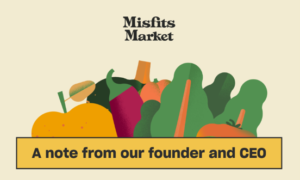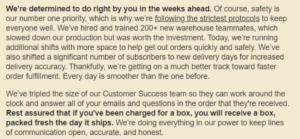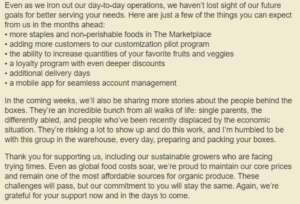Group Gordon’s Jordan Miller breaks down the features that make for good email communication with customers, especially when a brand stumbles.
New York has been in quarantine (or, as some would put it, on “PAUSE”) for one hundred years. Time is meaningless, measured in the space between Zoom calls. People are being forced to spend quality time with family and roommates. In other words: chaos.
As always, I find solace in cooking; planning menus and prepping ingredients allows me to retain some semblance of a routine. Last year (or, as I’ve been calling it, “The Time Before”) I subscribed to a weekly produce delivery from Misfits Market, and I’d always look forward to returning from work on Friday evenings to find my mystery box waiting for me (I lead a very exciting life).
When New Yorkers began to scramble to find grocery delivery options and Fresh Direct timeslots became harder to secure than a seat on the subway during rush hour in The Time Before (see? It flows nicely), Misfits Market quickly amassed more subscribers than it could handle. Complaints started piling up on social media: late or damaged deliveries, incorrect charges, inaccessible customer service.
To be clear, all of these are miniscule problems compared to the health and economic crises triggered by Covid-19, but they nonetheless threatened Misfits’ brand. For me, it was a disappointment to lose the weekly delivery—one of the last remaining pieces of my “normal” routine—and I worried about the safety of the workers and the supply chain.
Fast forward to last week: Misfits sent out an email to subscribers to apologize and explain the situation. As both a consumer and a comms person, I appreciated it. Here’s why:

It came from the CEO: The note was framed differently than other emails I’ve received in the past; it came from leadership, which showed that Misfits was taking the situation seriously.

It was personal and it got to the point quickly: The people behind the company—all of them—were mentioned up front, and the biggest issues were addressed first: the company acknowledged the problem, gave a realistic estimate of what the road ahead looks like, and told customers what it’s doing to right the ship.

It took responsibility: The company provided the context to help consumers understand the situation but didn’t shy away from admitting that things didn’t go smoothly.

It laid out a plan: The company recognized that doing right by the customer means more than an on-time delivery: I want to know that my purchase is helping to employ more people and that the workers are safe. At the same time, Misfits made it clear that it would fulfill every order.

It looked to the future: The email ended with something to look forward to—not just new products, but also a promise for more transparency about the people behind the produce.
Can one email completely address my ethical concerns around buying anything amid Covid-19, or around the produce delivery industry as a whole? Of course not. But it did what it needed to do: reassure me (and other customers) that things are going to be OK. Eventually. (Probably.)
For now, at the very least, my meal planning routine is back on schedule. This week, I used the time I would have spent worrying about my produce delivery to make a donation to Feeding America’s COVID-19 Response Fund, which is helping stock food banks that support vulnerable people facing hunger across the country.
Most businesses could not have predicted or prevented the massive disruption wrought by Covid-19. What they can control is their response. Despite everything, the building blocks of a good apology—humility, clarity, and a plan to do better—are as relevant as ever.